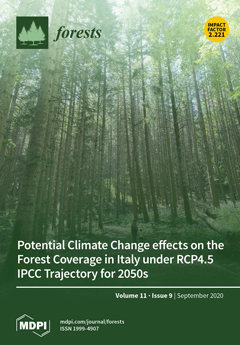The scaling relationship between either leaf dry or fresh mass (
M) and surface area (
A) can reflect the photosynthetic potential and efficiency of light harvesting in different broad-leaved plants. In growing leaves, lamina area expansion is typically finished before the completion of leaf biomass accumulation, thereby affecting the
M vs.
A scaling relationship at different developmental stages of leaves (e.g., young vs. adult leaves). In addition, growing plants can have different-sized leaves at different plant ages, potentially also changing
M vs.
A scaling. Furthermore, leaf shape can also change during the course of ontogeny and modify the
M vs.
A scaling relationship. Indeed, the effect of seasonal changes in leaf shape on
M vs.
A scaling has not been examined in any previous studies known to us. The study presented here was conducted using two deciduous tree species:
Alangium chinense (saplings forming leaves through the growing season) and
Liquidambar formosana (adult trees producing only one leaf flush in spring) that both have complex but nearly bilaterally symmetrical leaf shapes. We determined (i) whether leaf shapes differed in spring versus summer; (ii) whether the
M vs.
A scaling relationship varied over time; and (iii) whether there is a link between leaf shape and the scaling exponent governing the
M vs.
A scaling relationship. The data indicated that (i) the leaf dissection index in spring was higher than that in summer for both species (i.e., leaf-shape complexity decreased from young to adult leaves); (ii) there was a significant difference in the numerical value of the scaling exponent of leaf perimeter vs. area between leaves sampled at the two dates; (iii) spring leaves had a higher water content than summer leaves, and the scaling exponents of dry mass vs. area and fresh mass vs. area were all greater than unity; (iv) the scaling relationship between fresh mass and area was statistically more robust than that between leaf dry mass and area; (v) the scaling exponents of leaf dry and fresh mass vs. area of
A. chinense leaves in spring were greater than those in summer (i.e., leaves in younger plants tend to be larger than leaves in older plants), whereas, for the adult trees of
L. formosana, the scaling exponent in spring was smaller than that in summer, indicating increases in leaf dry mass per unit area with increasing leaf age; and (vi) leaf shape appears not to be related to the scaling relationship between either leaf dry or fresh mass and area, but is correlated with the scaling exponent of leaf perimeter vs. area (which tends to be a ½ power function). These trends indicate that studies of leaf morphometrics and scaling relationships must consider the influence of seasonality and plant age in sampling of leaves and the interpretation of data.
Full article





